Spider plant (Chlorophytum): Varieties, Benefits, and How to Care Guide
Is your home too plain and you are wondering what you can do to make it more lively and colorful? Well, a spider plant can easily add color to your home while adding a natural vibe. The plant’s name is nothing to worry about; it doesn’t bring spiders. On the contrary, the spider plant is a rather captivating plant with many varieties to select from. We will cover the numerous spider plant varieties along with their benefits and how to take proper care of them. Keep reading to find out more.
What is a spider plant?

A Spider plant is one of the most popular indoor plants with striking foliage. The plant has long narrow arched leaves that grow to form a rosette. The Spider plant grows long stems that produce tiny white flowers and small plantlets that you can propagate into new spider plants. The Spider plant’s leaves can be green or variegated depending on the species.
Hanging spider plants are especially ornamental and pleasing to the eye. You can plant your spider plant in a hanging basket to complement your décor. A Spider plant is relatively easy to grow and maintain making it a suitable choice for beginners.
You can find a Spider plant for sale by searching for “spider plants near me” online. As long as you provide ideal growing conditions for your plant, you can rest assured that your Spider plant will thrive.
Unlike other plant varieties, the spider plant is safe for cats and dogs. This plant is considered non-toxic to cats and dogs. However, your pets might destroy your plant and it would be best to keep it away from them.
Benefits of growing a Spider plant
You will benefit from growing a spider plant in the following ways:
Improved indoor air quality
According to a NASA study, the Spider plant can remove toxins from the air resulting in improved indoor air quality. Some of these toxins cause allergies and getting a Spider plant might just be the perfect solution for your constant allergies. Due to the spider plant’s air-purifying qualities, it can be a good plant for your bedroom.
Therapeutic
Growing a spider plant indoors can be therapeutic. The plant provides a natural, stress-free, and anxiety-free vibe that calms you and helps you relax. The plant induces positive energy and lifts your mood. You should definitely consider buying a spider plant.
Easy to grow
There are times when you totally forget you own a plant. Fortunately for you, the Spider plant can tolerate neglect for a while. This plant is not too demanding and thrives in imperfect conditions. However, you will still have to make an effort for your plant to remain healthy.
Different spider plant varieties
There are different types of spider plants you can choose from. These plants are available in solid green spider plant varieties and variegated spider plant varieties. We will cover several spider plant varieties with pictures.
Bonnie Spider plant (Chlorophytum comosum ‘Bonnie’)
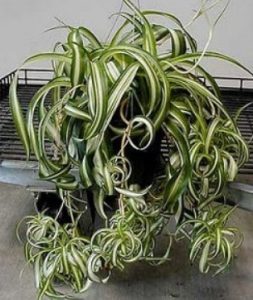
Also known as the Curly Spider plant, the Bonnie Spider plant is a popular spider plant variety with long, narrow, curly leaves. The plant’s leaves are variegated with white stripes that run along the length of the leaves. This versatile plant blends well with any kind of interior décor. One of the plants similar to the Bonnie Spider plant is Vittatum.
Hawaiian Spider plant (Chlorophytum viridescens ‘Hawaiian’
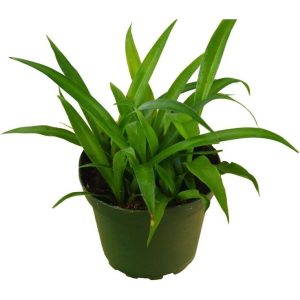
The Hawaiian Spider plant also known as the Golden Glow, is a unique type of plant with long narrow arching leaves. The plant’s leaves are light green with yellow streaks running along the leaves’ length. You can grow your Hawaiian spider plant indoors with ease under ideal conditions.
Zebra Spider plant (Chlorophytum laxum)
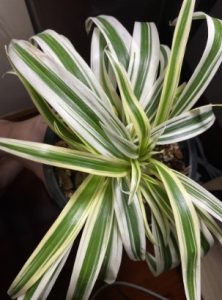
The Zebra Spider plant is a distinctive spider plant variety with long arched leaves. The plant has green leaves with yellow-colored edges that turn white as the plant matures. This plant gets its name from its striped leaves. The plant’s unique foliage adds a classic appearance to your home.
Variegated Spider plant (Chlorophytum comosum ‘Vittatum’)
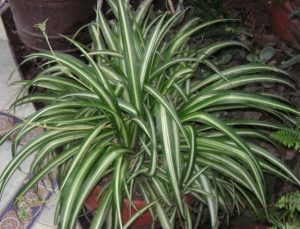
The Variegated spider plant is a common evergreen spider plant variety grown indoors. This plant has long slightly arched variegated leaves. This large Spider plant has light green leaves with broad yellow stripes in the middle. This spider plant variety can grow up to 2 feet tall and wide making a bold statement in your household.
Airplane spider plant (Chlorophytum comosum’Variegatum’)
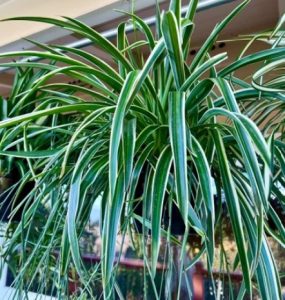
Also known as the Reverse Spider plant, this unique spider plant variety can be an ideal addition to your houseplant collection. The large Spider plant gets its name from its variegation. Unlike the other spider plants with green leaves and yellow stripes in the middle, the Reverse Spider plant has long arched leaves with a broad green stripe at the middle and yellow stripes at their margins.
Ocean spider plant (Chlorophytum comosum ‘Ocean’)
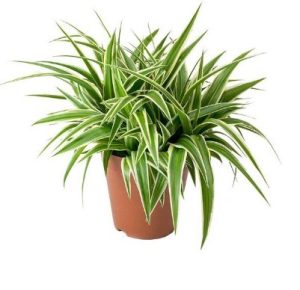
The Ocean Spider plant is a compact spider plant variety that is ideal for small spaces. The plant can also be used as a hanging Spider plant to enhance your home’s aesthetics. The plant has narrow arched leaves with green centers and yellow margins. The Ocean Spider plant produces small spider plants and tiny flowers when it matures.
Variegated Bonnie Spider plant (Chlorophytum comosum ‘Bonnie Variegated’
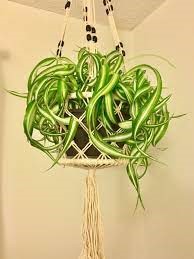
The Variegated Bonnie Spider plant is an attractive spider plant variety you can use to accentuate your home. The plant has long variegated curly leaves. The plant’s leaves are light green with yellow stripes. This plant is a great choice for your household.
Fire Flash Spider plant (Chlorophytum orchidastrum ‘Green Orange’)
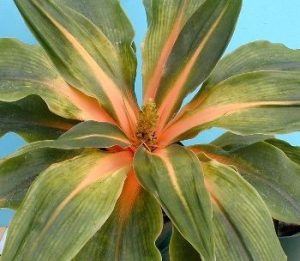
The Fire Flash Spider plant is a distinctive large Spider plant variety. Unlike other spider plant varieties, this plant has long broad solid green leaves and thick orange stems that mimic the appearance of fire. This fiery plant produces white flowers during the summer. You can find a Fire Flash spider plant for sale when you search online.
Bichetii Spider plant (Chlorophytum Bichetii)
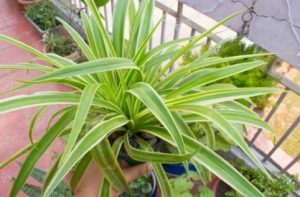
The Bichetii spider plant is a striking houseplant that you can place in a focal point of your home. This plant is non-flowering and does not produce off-shoots. The Bichetii Spider plant has long thin variegated leaves with green streaks at the middle and yellow margins.
Green Spider plant (Chlorophytum comosum ‘Green’)
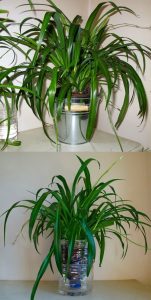
The Green Spider plant is an attractive plant popular for its lush foliage. The solid green spider plant has long narrow green leaves making it an excellent indoor plant addition. However, this plant is very rare to find. Therefore, if you come across this variety, don’t let the opportunity slip by.
Spider plant maintenance
Taking care of a Spider plant is relatively easy. You just have to provide the right conditions for your plant to thrive. Here is how you take care of your spider plant.
Spider plant sunlight
The spider plant prefers bright indirect sunlight to thrive. Exposing your plant to direct sunlight will scorch its beautiful foliage. Try to shield your plant from intense light using sheer curtains. You can instead place your plant near a window with adequate lighting. Too little light will make your plant grow slowly and fail to produce plantlets.
Spider plant water
Spider plants require moderate watering to survive. Wait for the soil to dry out before watering your plant. When watering your plant, ensure the soil is moist but not soggy. Wet soil will cause root rot which will eventually kill your Spider plant. Before returning your spider plant to its location, ensure the water drains out completely.
Try to use distilled water to water your spider plant. The plant’s leaves are sensitive to minerals and salts that can be present in water. These chemicals will cause brown tips on your plant’s leaves.
Spider plant soil type
Your spider plant will thrive in a well-draining loamy soil mixture. Ensure you plant your Spider plant in a pot with drainage holes on the bottom to prevent waterlogging. You can grow your plant in neutral, slightly alkaline, or slightly acidic soil.
Spider plant humidity and temperature
Moderately humid and warm conditions are ideal for your spider plant. Your plant will thrive under room temperature conditions. However, temperatures below 50 degrees will harm your plant. Try to keep your plant away from air vents and drafty doors and windows. When the air becomes too dry, your plant’s leaves will begin to turn brown. However, regularly misting your plant will help maintain ideal humidity levels.
Spider plant repotting
You will need to re-pot your plant after every 2 to 3 years. You might notice your plant’s roots protruding from the pot’s drainage holes. When this happens, use a slightly larger container to re-pot your plant. Always use fresh soil to re-pot your Spider plant.
Propagating spider plants in water
You can propagate your Spider plant in water using plantlets by following these steps.
- Cut off the plantlet from the parent plant
- Place your plantlet in a vessel and add water
- Your water should just cover the roots
- Place your plant in bright indirect light and wait for roots to form
- Regularly change your water
- Once the roots grow about 2 inches, transfer your plantlet to a potting media with well-draining soil
Toxicity
You don’t have to worry about placing your spider plant in the same location as your cat or dog. This is because the spider plant is non-toxic and therefore safe for your pets. The plant does however contain substances that cause mild hallucinations when ingested. We can agree that you don’t want your cats or dogs hallucinating. The best thing is to keep the plants away from your pets.
Spider plants are common houseplants that can make an excellent indoor plant addition. These low-maintenance plants are available in many varieties and you can choose one depending on your taste and needs. You can always propagate a new spider plant from the tiny plantlets that grow from the mother plant’s stem or buy a spider plant online. If you require more assistance, reach out to us today.
